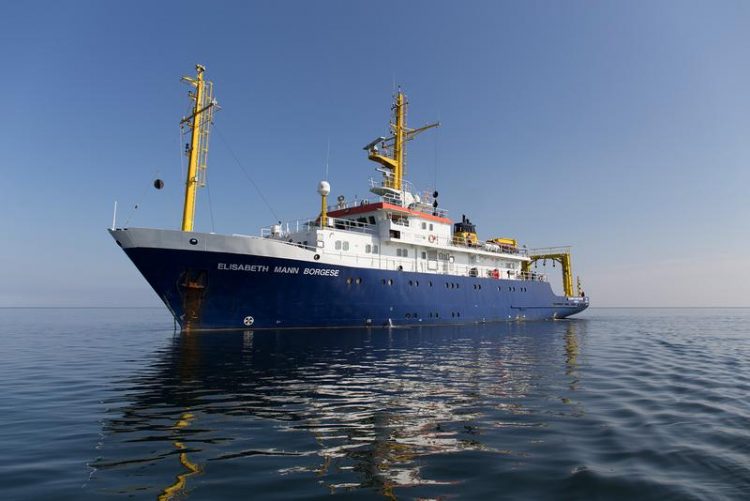IOW expedition studies eddies in the Baltic Sea to collect data for im-proving climate modelling

Participates in the big hunt for tiny turbulences on the Baltic Sea: the IOW research vessel ELISABETH MANN BORGESE IOW / S. Kube
Marine currents consist of a great number of eddies that vary in dimension from a few millimetres to several hundred kilometres. Even the smallest of them can influence huge ocean currents like the Gulf Stream along a causal chain and thereby can noticeably impact our climate. Details of the underlying mechanisms, however, are only poorly understood. The current expedition of the ELISABETH MANN BORGESE aims at contributing to our understanding of ocean eddies in general and their role as climate impact factors in particular.
“The Baltic Sea is an ideal research area, because it is much easier to study these processes in great detail in an inland sea than under the harsh conditions of the open ocean,” explains IOW physicist and cruise chief scientist Lars Umlauf, who coordinates the expedition’s international 12-person research team.
Together with HZG colleagues, the IOW team focuses on eddy structures in the sea’s surface layer. There, the eddies are in constant contact with the atmosphere. This is why it is presumed that they have a significant influence on the thermal exchange between the atmosphere and the ocean and on how much of the greenhouse gas CO2 the latter can absorb.
Therefore, the researchers will analyse the structure of the water column in the top 30 to 40 metres very thoroughly by measuring standard parameters such as temperature and salinity as well as by employing specialized probes that register tiny turbulences in the size range of millimetres and centimetres. These probes are mounted on two ocean gliders, which cruise autonomously through the water like underwater sailplanes, and on a measuring platform that is attached to a mooring on the seafloor and ascends and descends through the water column at predefined intervals.
The collected data will be used for the development of models, which will allow for a better understanding of mixing processes in the water and exchange processes between the atmosphere and the sea.
“For us, the expedition is a kick-off for our work within the collaborative research center ‘Energy Transfers in Atmosphere and Ocean’, which is funded by the German Research Association (DFG) with 9 million Euros in total. It officially starts on July 1 and is intended to ultimately improve the predictive accuracy of our climate models,” says so Lars Umlauf.
Scientists from the Alfred-Wegener-Institute, Helmholtz Centre for Polar and Marine Research (AWI), who also participate in the current expedition of the ELISABETH MANN BORGESE, will take water samples to analyse by means of molecular biological methods, whether the eddies provide a suitable habitat for certain microorganisms.
IOW’s research cruise is integrated into the extensive measuring campaign “Clockwork Ocean”, which takes place simultaneously and is coordinated by the HZG. As a premiere in marine research, a manned zeppelin is used to constantly provide highly precise infrared camera aerial photos of surface eddies to the scientists on board of the ELISABETH MANN BORGESE and several other, smaller research vessels. Therefore, smooth team work between the various working groups will be as crucial to the expedition’s success as the employed technology: “For us, HZG’s big ‘Clockwork Ocean’ initiative is very important. The zeppelin will help us to quickly identify and reach interesting eddy structures within the research area. In turn, the zeppelin’s infrared measurements, which only analyse the top millimetres of the water column, are very well supplemented by our measurements which cover the whole depth of the surface layer. By pooling their resources, all participating institutions have gained a lot more than what they would have achieved on their own,” Lars Umlauf concludes.
*Scientific contact:
Dr. Lars Umlauf | lars.umlauf@io-warnemuende.de
*Further information on the HZG project “Clockwork Ocean”:
http://www.uhrwerk-ozean.de/index.html.en
*Press and Public Relations at IOW:
Dr. Kristin Beck | Phone: +49 (0)381 – 5197 135 | kristin.beck@io-warnemuende.de
Dr. Barbara Hentzsch | Phone: +49 (0)381 – 5197 102 | barbara.hentzsch@io-warnemuende.de
The IOW is a member of the Leibniz Association with currently 88 research institutes and scientific infrastructure facilities. The focus of the Leibniz Institutes ranges from natural, engineering and environmental sciences to economic, social and space sciences as well as to the humanities. The institutes are jointly financed at the state and national levels. The Leibniz Institutes employ a total of 18.100 people, of whom 9.200 are scientists. The total budget of the institutes is 1.6 billion Euros. (http://www.leibniz-association.eu)
Media Contact
All latest news from the category: Earth Sciences
Earth Sciences (also referred to as Geosciences), which deals with basic issues surrounding our planet, plays a vital role in the area of energy and raw materials supply.
Earth Sciences comprises subjects such as geology, geography, geological informatics, paleontology, mineralogy, petrography, crystallography, geophysics, geodesy, glaciology, cartography, photogrammetry, meteorology and seismology, early-warning systems, earthquake research and polar research.
Newest articles

Properties of new materials for microchips
… can now be measured well. Reseachers of Delft University of Technology demonstrated measuring performance properties of ultrathin silicon membranes. Making ever smaller and more powerful chips requires new ultrathin…

Floating solar’s potential
… to support sustainable development by addressing climate, water, and energy goals holistically. A new study published this week in Nature Energy raises the potential for floating solar photovoltaics (FPV)…

Skyrmions move at record speeds
… a step towards the computing of the future. An international research team led by scientists from the CNRS1 has discovered that the magnetic nanobubbles2 known as skyrmions can be…




















